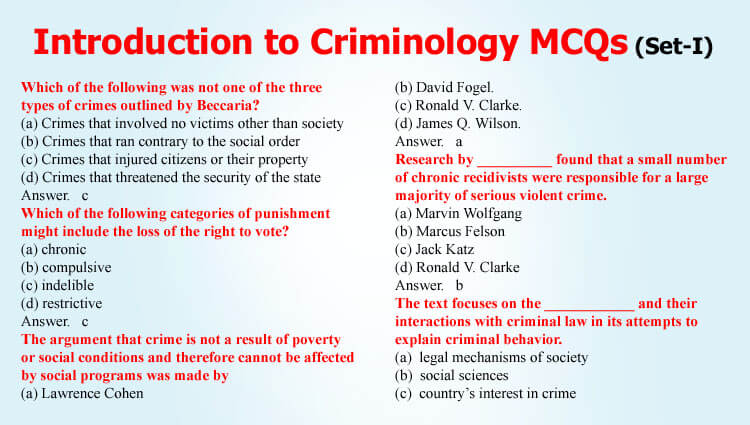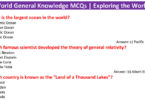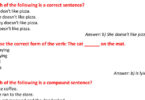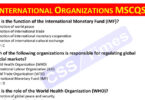Which of the following was not one of the three types of crimes outlined by Beccaria?
(a) Crimes that involved no victims other than society
(b) Crimes that ran contrary to the social order
(c) Crimes that injured citizens or their property
(d) Crimes that threatened the security of the state
Answer. c
Which of the following categories of punishment might include the loss of the right to vote?
(a) chronic
(b) compulsive
(c) indelible
(d) restrictive
Answer. c
The argument that crime is not a result of poverty or social conditions and therefore cannot be affected by social programs was made by
(a) Lawrence Cohen
(b) David Fogel.
(c) Ronald V. Clarke.
(d) James Q. Wilson.
Answer. a
Research by __________ found that a small number of chronic recidivists were responsible for a large majority of serious violent crime.
(a) Marvin Wolfgang
(b) Marcus Felson
(c) Jack Katz
(d) Ronald V. Clarke
Answer. b
The text focuses on the ____________ and their interactions with criminal law in its attempts to explain criminal behavior.
(a) legal mechanisms of society
(b) social sciences
(c) country’s interest in crime
(d) scientific reports
Answer. b
A crime must be proven
(a) by a preponderance of the evidence
(b) by clear and convincing evidence
(c) beyond a reasonable doubt
(d) beyond all doubt
Answer. c
Mens rea, or criminal intent, is required to establish:
(a) rationality (a) liability
(b) Culpability (c) innocence
Answer. c
If a person commits arson and the death of another results from it, even though s/he had no intent to cause the death of anyone, s/he may be charged with murder under the:
(a) irresistible impulse doctrine
(b) felony-murder doctrine
(c) the Durham rule
(d) direct responsibility rule
Answer. b
Which of the following are functions of law?
(a) defining parameters of private and public property
(b) regulating social relationship such as marriage
(c) maintaining the status quo and power relationships
(d) all of the above
Answer. d
Which criminal justice perspective emphasizes the efficient arrest and conviction of criminal offenders?
(a) Crime-control model
(b) Due process model
(c) Interactionist model
(d) Administrative model
Answer. a
Which criminal justice perspective emphasizes individual rights at all stages of justice system processing?
(a) Crime-control model
(b) Due process model
(c) Interactionist model
(d) Administrative model
Answer. b
What is defined as a series of interrelated propositions that attempt to describe, explain, predict, and ultimately control some class of events?
(a) System
(b) Network
(c) Probability
(d) Theory
Answer. d
According to John F. Galliher, legal definitions of criminality are arrived at through a __________ process.
(a) sociological
(b) psychological
(c) political
(d) mainstream
Answer. a
Ron Classen sees crime primarily as
(a) a violation of a law.
(b) problem behaviour.
(c) an offense against human relationships
(d) a form of social maladjustment.
Answer. c
The pluralistic perspective suggests that behaviours are typically criminalized through
(a) general agreement of members of society.
(b) a political process
(c) the existence of shared norms and values.
(d) none of the above
Answer. b
Which of the following jobs probably would not fall within the field of criminalistics?
(a) Fingerprint examiner
(b) Polygraph operator
(c) Forensics examiner
(d) Correctional officer
Answer. c
A police officer or probation officer is best described as a
(a) criminalist.
(b) criminologist
(c) criminal justice professional
(d) none of the above
Answer. c
__________ definitions focus on criminology’s role in uncovering the underlying causes of crime
(a) Scientific
(b) Causative
(c) Disciplinary
(d) None of these
Answer. a
According to various professional groups, violence in television, music, video games, and movies
(a) may lead to increased levels of violent behaviour among children.
(b) may lead to decreased levels of violent behaviour among children
(c) may lead to emotional sensitization toward violence in real life
(d) may have no effect on levels of violent behaviour among children
Answer. d
Which of the following is not an immediate input provided by the justice system that may enhance or reduce the likelihood of criminal occurrences?
(a) Police response time to a crime scene
(b) The presence or absence of police officers
(c) A prison that acts as a “crime school”
(d) Both a & b
Answer. d
Which of the following is not considered a property crime by the UCR?
(a) Robbery
(b) Burglary
(c) Arson
(d) Theft
Answer. b
Which of the following is not a reason why rape victims fail to report their victimization?
(a) Fear that the crime is not important enough to report
(b) Fear of the perpetrator
(c) Fear of participation in the criminal justice system
(d) Shame
Answer. d
According to Elliott Currie, the ______ is the rate of crime calculated on the basis of crimes that would likely be committed by those who are incapacitated by the criminal justice system.
(a) actual crime rate
(b) criminality index
(c) latent crime rate
(d) clearance rate
Answer. d
The first step in any research is to
(a) develop a research design
(b) choose a data collection technique.
(c) review the findings.
(d) identify a problem.
Answer. a
A __________ is especially valuable when aspects of the social setting are beyond the control of the researcher.
(a) one-group pretest-posttest design
(b) case study
(c) controlled experiment
(d) quasi-experimental design
Answer. c
This is often called the reality principle.
(a) Id
(b) Ego
(c) Superego
(d) None of these
Answer. b
The conditions of a weak superego, sublimation, or a death wish being possible sources of criminal behaviour are part of what theory?
(a) Anomie
(b) Social learning
(c) Primary deviance
(d) Psychoanalysis
Answer. d
This perspective states that formal agencies of social control at best merely coerce the unempowered or the disenfranchised to comply with the rules established by those in power.
(a) Social control
(b) Neoclassical
(c) Labeling
(d) Conflict
Answer. d
Who are the theorists of peacemaking criminology?
(a) Park and Burgess
(b) Sykes and Matza
(c) Cloward and Ohlin
(d) Pepinsky and Quinney
Answer. d
This theory has also been called compassionate criminology.
(a) Critical criminology
(b) Social control theory
(c) Peacemaking criminology
(d) General theory of crime
Answer. c
Crimes that occur because of a diseased mind or a disordered personality may be from conditions known as what?
(a) Secondary deviance
(b) Legal relativism
(c) Subculture of violence
(d) Psychopathy
Answer. d
What assumptions are included in most classical theories of crime causation?
(a) Pain and pleasure are the two central determinants of human behaviour
(b) Crime prevention is possible through swift and certain punishment that offsets any gains to be had through criminal behaviour
(c) Crime is caused by the individual exercise of free will
(d) All of the above
Answer. d
This theory posits that lifestyles significantly affect both the volume and type of crime found in any society and the risk of criminal victimization varies dramatically among the circumstances and locations in which people place themselves and their property.
(a) Routine activities theory
(b) Anomie
(c) Positivism
(d) Conflict theory
Answer. a
What is a main proposition of routine activities theory?
(a) Criminal behaviour is learned
(b) Crime is the result of the powerful asserting their dominance over the powerless
(c) Crime is the result of a weakening of the bonds to society
(d) Crime is likely to occur when a motivated offender and a suitable target come together in the absence of a capable guardian
Answer. d
What term describes a throwback to earlier stages of evolution where individuals were not sufficiently mentally advanced for successful life in the modern world?
(a) Anomie
(b) Somatotype
(c) Atavism
(d) Innovator
Answer. c
According to Sheldon, which body type is most prone to aggression, violence, and delinquency?
(a) Endomorphs
(b) Ectomorphs
(c) Mesomorphs
(d) Blotomorphs
Answer. c
This United States Supreme Court case dealt with the eugenics movement.
(a) Brown v. Board of Education
(b) Buck v. Bell
(c) Boston v. United States
(d) Becker v. New York
Answer. b
These theories highlight the role of human DNA, environmental contaminants, nutrition, hormones, physical trauma, and body chemistry in human cognition, feeling, and behaviour.
(a) Classical School
(b) Social process
(c) Conflict
(d) Psychobiology
Answer. d
This is a psychological principle that holds that the frequency of any behaviour, including criminal or deviant behaviour, can be increased or decreased through reward, punishment, and association with other stimuli.
(a) Anomie
(b) Conflict
(c) Conditioning
(d) None of these
Answer. c
These individuals are characterized by disordered or disjointed thinking in which the types of logical associations they make are atypical of other people.
(a) Schizophrenics
(b) Innovators
(c) Ritualists
(d) Fatalists
Answer. a
This term is defined as the attempt to derive a composite picture of an offender’s social and psychological characteristics from the crime he/she committed and from the manner in which it was committed.
(a) Constitutive criminology
(b) Deviance detection
(c) Psychological profiling
(d) Crime scene separation
Answer. c
According to anomie theory, this individual agrees with the goals but disagrees with the means and may be involved in white-collar crimes or property crimes.
(a) Retreatist
(b) Rebel
(c) Ritualist
(d) Innovator
Answer. d
Edwin Sutherland formulated what theory?
(a) Anomie
(b) Culture conflict
(c) Social learning
(d) Differential Association
Answer. d
Who is the theorist for containment theory?
(a) Sutherland
(b) Merton
(c) Durkheim
(d) Reckless
Answer. d
Who are the theorists for techniques of neutralization?
(a) Sykes and Matza
(b) Gottfredson and Hirschi
(c) Wolfgang and Ferracuti
(d) Burgess and Akers
Answer. a
Who is the theorist of social control theory?
(a) Reckless
(b) Merton
(c) Hirschi
(d) Pepinski
Answer. c
The Program of Research on the Causes and Correlates of Delinquency identified three distinct pathways to delinquency. This pathway is marked by minor aggression, such as bullying, that develops around age 11 or 12 and leads to fighting and physical violence.
(a) Authority of conflict pathway
(b) Overt pathway
(c) Covert pathway
(d) None of the above
Answer. b
This perspective placed the blame for criminality and deviant behavior squarely on officially sanctioned cultural and economic arrangements. The distribution of wealth and power in society was held to be the primary cause of criminal behavior.
(a) Peacemaking criminology
(b) Radical criminology
(c) Right realism
(d) Retrospective interpretation
Answer. b
This criminology refers to the process by which human beings create “an ideology of crime that sustains it as a concrete reality.” A central feature is its assertion that individuals shape their world while also being shaped by it.
(a) Somatotypes
(b) Constitutional criminology
(c) Constitutive criminology
(d) Social learning theory
Answer. c
This theory views crime as the product of socialization and sees it as being acquired by criminals according to the same principles that guide the learning of law-abiding behavior in conformists.
(a) Differential association
(b) Concentric zone
(c) Containment
(d) Neutralization
Answer. a
Source: Criminology MCQs








I m looking for MCQ for Law related all subjects, I found that your MCQs are more appropriate, to set up test questions, Please, send /Post for ADR, Cyber Law, Media Law, Medical Jurisprudence, Constitution II, in earlier Please.